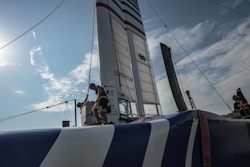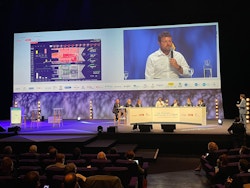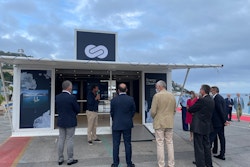The multiple challenges of the maritime energy transition
Commercial vessels, pleasure craft, nautical races: the environmental impact of maritime sector is multiple, and concerns industrialists, institutions, and individuals alike. Our team participated in several events in the south of France to present concrete solutions and meet the players who put these concerns at the heart of their strategy.

2.9% of the world's greenhouse gas emissions come from the maritime sector, 87% of which are from cargo ships. If international shipping wa treated as a country, it would be the 6th largest emitter of CO2 in the world, after the US, China, Russia, India and Japan.
This observation emphasises the impact of commercial ships on marine biodiversity. This impact does not only concern shipping, but also maritime mobility in general (for more information, you can listen to the presentation made by Victorien Erussard at the 5th Hydrogen Cycle Conference).
From the race for speed to the one of positive impact
The Sail Grand Prix race brings together F50s from eight different nations, competing for speed records of up to almost 100 km/hour on the water. The race within the race is the "Race for the future" programme, which aims to reduce the environmental impact of the competition and encourage the whole sector to "race for a better future". This "Impact League" ranking, which is played out on the side-lines of the Sail GP race, raises awareness of the need to have the lowest possible environmental impact. Each team is judged on 10 criteria inspired by the Sustainable Development Goals over a week, such as how they travel, transport their equipment, consume their food and recycle their waste. The biggest challenge is the fossil fuel consumption of the 18 motorboats that accompany them on each race for technical, safety and other purposes.
The event in Saint-Tropez was marked by the presence of a concrete zero emission solution, an electro-hydrogen generator developed by EODev which replaces diesel generators and can be used on the quayside for events.
New technologies for yachting
During the Cannes Yachting Festival, Katia Nicolet, marine biologist on board Energy Observer, went to discover the new technologies that will make tomorrow's boating more environmentally friendly. Today, only 9,000 pleasure boats are electric, i.e. 1% of the market. As much to say that the margin for progress is there!
The necessary evolution of regulations
The 16th edition of the Assises de l'Economie de la Mer in Nice brought together the main players in the maritime community. On the agenda for the 2021 edition: an economic revival against a backdrop of ecological transition.
All the economic and social subjects which affect the maritime sector, whether it be the consequences of the health crisis on employment and the economy of the sector, the more specific stakes of the yachting sector as well as the merchant navy or the port ecosystem, were tackled. But it was the urgency of the ecological transition that was at the heart of these 2021 conferences, and we can only welcome this.

Victorien Erussard at the "Assises de l'Économie de la Mer" - Nice, 2021
The presence of decision-makers from the public and private sectors also made this event an opportunity to evolve the regulations that will facilitate the development of new technologies for the maritime sector, although this was not on the official agenda.
The law is often slower than the market and innovation, which leads to a gap between the needs of the industry and a regulation that lags the reality of the field.
“Among the levers to be used as a priority between now and 2023 to reduce these emissions: reducing the speed of ships. In the medium term, i.e. by 2030, ship propulsion systems must also become more efficient. But it is above all the introduction of a specific carbon tax that would make the companies concerned make the right choices.”
Some examples are particularly relevant to us:
- Hydrogen pressurisation for ships. Today, cars can run on gaseous hydrogen stored at 700 bars, compared to 350 bars for ships, which is a hindrance to benefit from a greater autonomy, a determining element for maritime mobility.
- A network of hydrogen stations throughout the country to enable the development of hydrogen mobility on land and at sea.
- Adapting legislation to new hybrid propulsion systems using hydrogen as an energy carrier in order to free up energy resources.
- The standardization of regulations between ports in France to generalize and facilitate the use of hybrid and hydrogen propulsion vessels.
If, as the President of the Republic Emmanuel Macron underlined, "the sea is a space for innovation", we are convinced that it will provide solutions for the environment.




